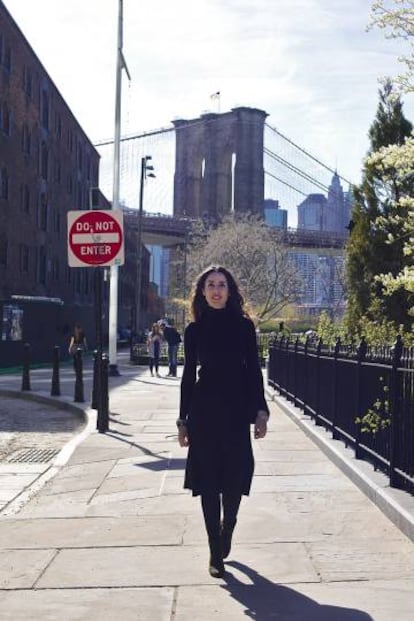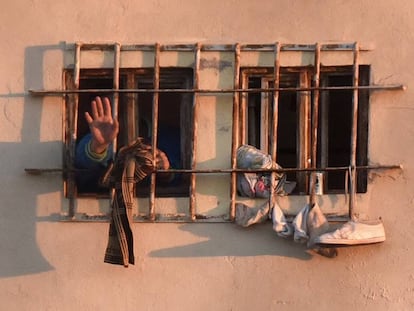Virginia Barber, a Spaniard in New York’s grimmest prison
The 39-year-old forensic psychologist from Lanzarote is about to become the mental health director at what is considered one of the worst jails in the US
Virginia Barber hardly spoke any English when she came to Manhattan to indulge her passion for forensic psychology. Today she is the new director of the mental health department at Rikers Island, one of America’s most notorious jails, where she is tackling the cracks in the system.

With 10,000 inmates, Rikers Island is the second-biggest penitentiary in the United States, with more mentally ill people than in any other corner of New York. It is an island where prisoners wait to be sentenced while being watched by 9,000 prison wardens. It’s the place where you would have found Mark David Chapman – the man who shot John Lennon – before he was sentenced. Or French politician Dominique Strauss-Kahn, or the rapper Lil Wayne. They all did time at this correctional center next to LaGuardia airport, voted number 10 in Mother Jones magazine’s 2013 list of America’s worst prisons.
Virginia Barber, a 39-year-old forensic psychologist from Lanzarote, is about to become the center’s mental health director. And she’s well qualified for the job. Her resume includes processing court cases for the mentally ill across New York and working on the team of clinical forensics at Bellevue Hospital.

Now, besides teaching at New York University and helping New York Mayor Bill de Blasio identify the main problems of the city’s criminal system, she will head a workforce of 250 psychologists, social workers, occupational and mental health therapists, besides 150 psychiatrists and nurses. Her goal is to reduce the levels of violence while managing the mental health issues that result in events such as the gruesome death of mentally ill inmate Bradley Ballard in 2014, and the subsequent media scrutiny.
Sitting in a Brooklyn café, Barber is so calm that it’s hard to believe she has spent much of her life treating rapists and murderers, as well evaluating the mental health of vulnerable people trapped in a complex system. For her, evil has a painfully human face.
“People often ask me how I can work in this field and still sleep at night,” she says. “The truth is I don’t always sleep well. Time doesn’t desensitize you but it does help you to accept that almost everything is out of your control, and that the main thing is to do what you can as well as possible. Even so, there are always situations, miscarriages of justice…”
After almost 20 years in New York, her vision of the city is brutally realistic while her compassion drives her constant struggle to improve a system desperately in need of change.
How did you become a forensic psychologist?
“While I was studying psychology in Madrid, I became interested in the relationship between this discipline and law, and one of my professors told me about the John Jay College of Criminal Justice in New York. But I think it really began with these heroin addicts I used to see on my way home from school. I wanted to know what was wrong with them. I did my internship during my degree at a drug dependence center and I could see that the people there were constantly in and out of jail and that a lot of them were mentally ill.”

You are about to apply your alternative programs to one of the most difficult prisons in America.
“Those programs belong to what we call therapeutic justice. The idea was developed by David Wexler and involves making the judicial process – from arrest to conviction – a therapeutic one. This involves setting up courts that specialize in drug dependency and mental health issues.”
Can anyone facing charges go through these special courts?
“No one charged with murder can be in these programs; nor prisoners known to have been suffering severe psychiatric problems when they committed their offense – these cases are not subject to criminal liability and go down a different judicial route.”
How do these programs work?
“The accused pleads guilty and then has to agree to a course of treatment while being reintroduced into the community. This means taking medication, undergoing therapy and a series of medical checks. If they do all this in the required time, the case against them is dropped. If they fail to comply, they have to go to prison.”

Can a rapist be released into society like this?
“We have to evaluate the risks of violence, whether general, sexual or domestic. If the prisoner in question is a rapist with paraphilia, he can’t be in the program. Only prisoners with levels of violence that can be managed within the community can be in it. It’s a balance between keeping people out of jail and maintaining public safety. Having said that, more than 90% of the mentally ill live all their lives without committing a violent act. Aggressive behavior is usually the result of other factors, such as drug addiction, trauma and personality disorders of an antisocial nature.”
Isn’t that a mental illness?
“It’s not considered a mental illness. It’s more of a personality disorder, which means the person finds it hard to adapt. It starts in childhood or adolescence and if it’s not treated it can last a lifetime. It produces violent attitudes, criminal tendencies and antisocial behavior – the type of conduct that prison culture or street gangs aggravate. The difference is that a mental illness is episodic; it can go into remission if treated. Antisocial personality disorders or psychopathic behavior are a way of being.”
In America, an estimated 40% of prisoners are mentally ill.
“That figure includes people who have a mental health condition like depression. Only 7% have a serious mental illness. It’s still a much higher percentage than in society at large where it is around 3%. In Spain, according to Mercedes Gallizo, former director of the country’s penal institutions, prisoners with serious mental health issues make up 25% of the prison population.”

How has being Spanish helped you in your career in the US?
“Most of the prisoners are either African-American or Hispanic. Things are improving slowly but there are many people inside who don’t need to be. For example, many years ago, a man was arrested for being drunk in the street. He was under arrest for three days. Fifteen years later – then married with kids – he was picked up by immigration and sent to jail for two years. A lot of people like him have no right to counsel. There is also a notable number of mentally ill among them.”
How accurate are your evaluations when it comes to risk of violence and repeat offending?
“There’s a margin of error because human behavior is hard to predict. In the past, when they only did one evaluation to determine whether the prisoner was dangerous or nor, the estimate was never more than 50% accurate. Now we’re at around 70%.”
Do you get scared when you’re evaluating a prisoner?
“Not usually. I can quickly see what mental state the prisoner is in. I check the medical and criminal records and I see what triggers their aggression. Also, there may be a lot of security measures in place during evaluation, depending on the case. But if I get scared – which can happen with psychopaths or highly manipulative prisoners, I trust my instincts and end the interview.”
Sign up for our newsletter
EL PAÍS English Edition is launching a weekly newsletter. Sign up today to receive a selection of our best stories in your inbox every Saturday morning. For full details about how to subscribe, click
.
Is it the case that the antidrug laws are partly responsible for such high rates of incarceration?
“In the so-called war against drugs, you used to get 15 years in jail for cocaine possession and the judges weren’t able to reduce the sentence. Right now, we’re at a critical moment in the reform of the criminal and judicial system.”
But so far the prison population remains high.
“Although alternative programs in New York are very advanced, the volume of prisoners is still huge. The public health service doesn’t have the resources to deal with mentally ill detainees that we are trying to reintroduce into the community. The price of health insurance and housing complicates things. You can reduce the number of people going to jail all you like, but if there are not enough resources in the community, the system is doomed to fail. New York is a challenge because there is a lot of immigration and incredible cultural differences.”
How do you deal with that?
“There needs to be a budget for treating the inmates who are reintroduced into society and also for support programs. More people need to be trained to deal with people whose behavior can be impulsive, aggressive and suicidal, sometimes as a result of trauma or drug dependency and not through mental illness. When I started working in this field, I focused a lot on serious psychiatric disorders, but I have since realized that the problem has more to do with a lack of socialization.
And that’s where other factors, such as economic ones, come into play.
“Stabilizing the mentally ill is relatively easy if you have a good team. The problem is that many people fall outside this diagnosis while still being incredibly impulsive, having zero tolerance for frustration and no skills when it comes to anger management. This is often due to circumstances they have been exposed to since birth.”
More people need to be trained to deal with people whose behavior can be impulsive, aggressive and suicidal, sometimes as a result of trauma or drug dependency and not through mental illness
How would these people be diagnosed?
“What they’re suffering is a kind of complex post-traumatic stress disorder. This was a common condition among veterans of the Vietnam War – their symptoms included hyper-vigilance and flashbacks. Among the prison population, many won’t fit this description exactly, but people who have suffered a recurring trauma growing up, such as being exposed to violence with no stable influence in their lives, will be more prone to aggression, hostility and impulsive behavior. This is a post-traumatic stress syndrome that is still not included in the Handbook of Diagnosis and Statistics of Mental Trauma.”
How is their condition being defined?
“There are very complex symptoms that mean you are very liable to commit crimes because you have a problem with authority, you yell at people, and if you are arrested you respond aggressively. Once inside the judicial system, it’s very difficult for these people to be admitted into the mental health courts or given bail. They have no emotional control over themselves. They go from 0 to 100 in no time, and don’t have the tools to come back down. This is a common problem among prisoners.”
English version by Heather Galloway.
Tu suscripción se está usando en otro dispositivo
¿Quieres añadir otro usuario a tu suscripción?
Si continúas leyendo en este dispositivo, no se podrá leer en el otro.
FlechaTu suscripción se está usando en otro dispositivo y solo puedes acceder a EL PAÍS desde un dispositivo a la vez.
Si quieres compartir tu cuenta, cambia tu suscripción a la modalidad Premium, así podrás añadir otro usuario. Cada uno accederá con su propia cuenta de email, lo que os permitirá personalizar vuestra experiencia en EL PAÍS.
¿Tienes una suscripción de empresa? Accede aquí para contratar más cuentas.
En el caso de no saber quién está usando tu cuenta, te recomendamos cambiar tu contraseña aquí.
Si decides continuar compartiendo tu cuenta, este mensaje se mostrará en tu dispositivo y en el de la otra persona que está usando tu cuenta de forma indefinida, afectando a tu experiencia de lectura. Puedes consultar aquí los términos y condiciones de la suscripción digital.
More information
Archived In
Últimas noticias
The complicated life of Francesca Albanese: A rising figure in Italy but barred from every bank by Trump’s sanctions
How Japan is trying to avert ‘digital defeat’
Reinhard Genzel, Nobel laureate in physics: ‘One-minute videos will never give you the truth’
Pinochet’s victims grapple with José Antonio Kast’s rise in Chile
Most viewed
- Pablo Escobar’s hippos: A serious environmental problem, 40 years on
- Why we lost the habit of sleeping in two segments and how that changed our sense of time
- Trump’s obsession with putting his name on everything is unprecedented in the United States
- The Florida Keys tourist paradise is besieged by immigration agents: ‘We’ve never seen anything like this’
- Charles Dubouloz, mountaineering star, retires at 36 with a farewell tour inspired by Walter Bonatti











































